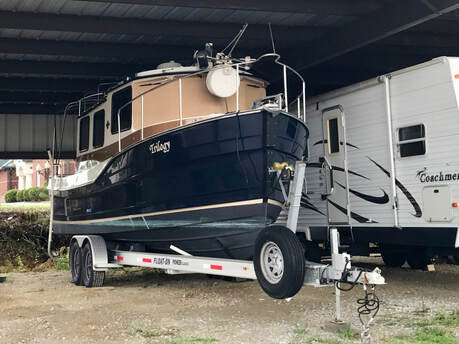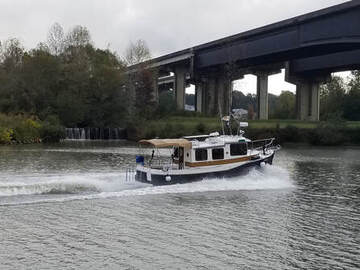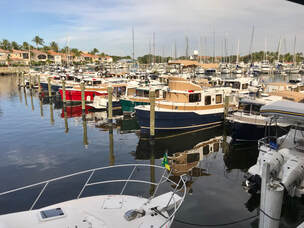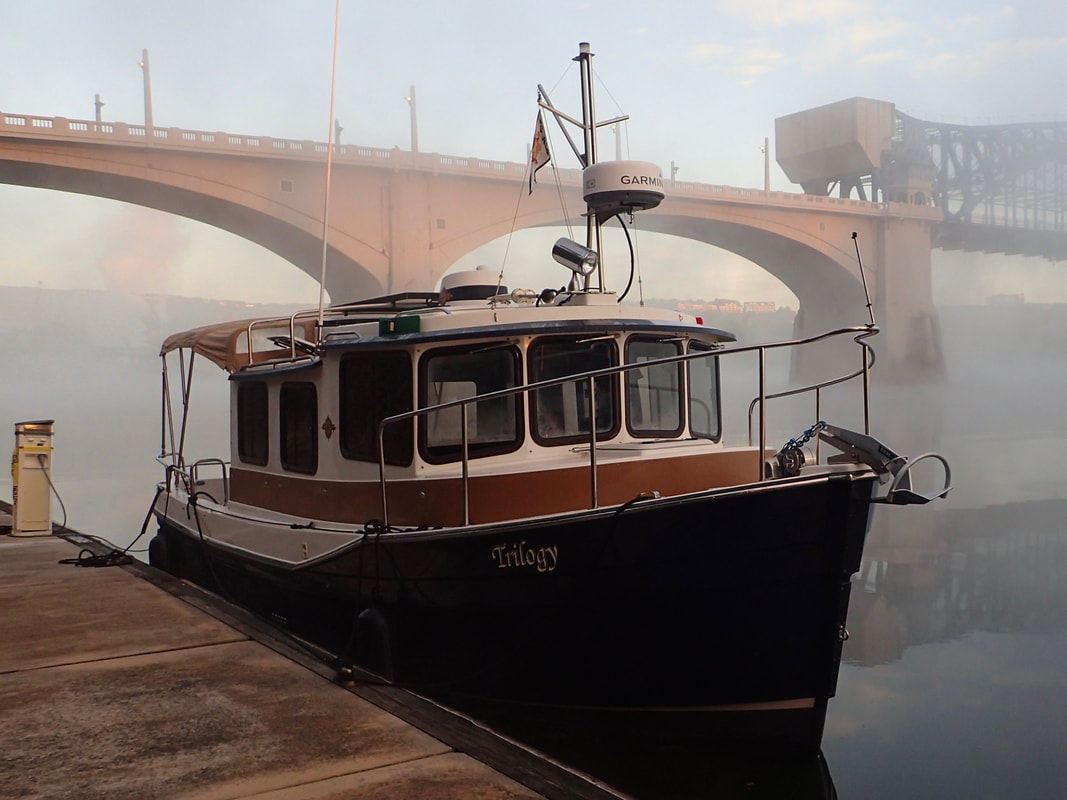Two Boats on Two Coasts
Having Boats On Two Coasts: Are We Crazy?
We are West Coast cruisers and based in Puget Sound. Our Kadey Krogen 39 Pilothouse is the best boat we have ever owned. See my site, www.tribute-kadeykrogen39.com. But it was not a movable boat unless we put it on a freighter. We had an idea, really a whim – not a plan, to have a boat that was east of the Mississippi River that we would go to and do parts of the Great Loop again and explore places that we had passed over three years earlier. We liked the way that Rich and Cheryl have used their Ranger Tug 25, Roam. See their website HERE. Though it is kept in Michigan, they trailer it around North America and do trips of 4 to 12 weeks. Listening to their latest adventure and the one they are planning to do, the notion of keeping a boat on a trailer and moving it as desired crystallized for us. The idea became an unexpected swift reality during a trip to Florida to see friends, take advantage of cheap airfares and to attend a rendezvous of Ranger Tug owners in SW Florida.
We have owned 8 cruising boats over nearly 30 years and I had taken the lead on finding and purchasing all of them but this would be different - Laurie did this one. The criteria was simple: a boat that was movable by either trailer or affordably moved by a professional and the price was under $100K. In four days, we looked at a Camano 31, a Rosborough, a C-Dory 25, a Tomcat, and this Ranger 27.
The tug was found and purchased in February, possession happened in March and it was moved to Save Cove Boat Yard and Storage in Port Charlotte where it was under cover and plugged into power. In May, a four-day sprint of repairs and improvements were done with the huge help of friends Paul and Stacy and then the boat was towed on its trailer to a storage yard in Ringgold, Georgia that is close to Chattanooga to get it out of the hurricane zone and to position it for a fall trip on the Tennessee River. When that river trip ended in Mobile, Alabama, it was left in a storage yard in nearby Saraland, Alabama. The following February, it was moved to St. Petersburg for the South Florida Trip and when that trip ended in Titusville, it was moved to a storage yard near Charlotte, North Carolina that was with an easy drive to the Great Lakes, Canada's Heritage Canals (Trent Severn Waterway & Rideau Canal), Lake Champlain and the Erie Canal.
The following summer, the tug took us 1,600 miles over 56 days to explore the whole length of the Erie Canal, the length of the Rideau Canal including the cities of Ottawa and Montreal, the Chambly Canal to Lake Champlain and the Hudson River, and the whole length of the Trent-Severn Waterway in Ontario, Canada. Then the tug was stored in Brunswick, Georgia. The following spring, Trilogy explored the Chesapeake Bay including the cities of Baltimore and Annapolis. The following winter, the tug was launched in Punta Gorda, Florida for the Southwest Florida Tug Rendezvous and it explored the west coast and then moved to the ICW in Brunswick, Georgia and headed north through Savannah, Beaufort and Charleston to Southport, North Carolina.
In the fall, the tug was trailered back to where it was built, Puget Sound, Washington. We had cruised nearly 5,000 miles and put 500 hours on its engine.
We are West Coast cruisers and based in Puget Sound. Our Kadey Krogen 39 Pilothouse is the best boat we have ever owned. See my site, www.tribute-kadeykrogen39.com. But it was not a movable boat unless we put it on a freighter. We had an idea, really a whim – not a plan, to have a boat that was east of the Mississippi River that we would go to and do parts of the Great Loop again and explore places that we had passed over three years earlier. We liked the way that Rich and Cheryl have used their Ranger Tug 25, Roam. See their website HERE. Though it is kept in Michigan, they trailer it around North America and do trips of 4 to 12 weeks. Listening to their latest adventure and the one they are planning to do, the notion of keeping a boat on a trailer and moving it as desired crystallized for us. The idea became an unexpected swift reality during a trip to Florida to see friends, take advantage of cheap airfares and to attend a rendezvous of Ranger Tug owners in SW Florida.
We have owned 8 cruising boats over nearly 30 years and I had taken the lead on finding and purchasing all of them but this would be different - Laurie did this one. The criteria was simple: a boat that was movable by either trailer or affordably moved by a professional and the price was under $100K. In four days, we looked at a Camano 31, a Rosborough, a C-Dory 25, a Tomcat, and this Ranger 27.
The tug was found and purchased in February, possession happened in March and it was moved to Save Cove Boat Yard and Storage in Port Charlotte where it was under cover and plugged into power. In May, a four-day sprint of repairs and improvements were done with the huge help of friends Paul and Stacy and then the boat was towed on its trailer to a storage yard in Ringgold, Georgia that is close to Chattanooga to get it out of the hurricane zone and to position it for a fall trip on the Tennessee River. When that river trip ended in Mobile, Alabama, it was left in a storage yard in nearby Saraland, Alabama. The following February, it was moved to St. Petersburg for the South Florida Trip and when that trip ended in Titusville, it was moved to a storage yard near Charlotte, North Carolina that was with an easy drive to the Great Lakes, Canada's Heritage Canals (Trent Severn Waterway & Rideau Canal), Lake Champlain and the Erie Canal.
The following summer, the tug took us 1,600 miles over 56 days to explore the whole length of the Erie Canal, the length of the Rideau Canal including the cities of Ottawa and Montreal, the Chambly Canal to Lake Champlain and the Hudson River, and the whole length of the Trent-Severn Waterway in Ontario, Canada. Then the tug was stored in Brunswick, Georgia. The following spring, Trilogy explored the Chesapeake Bay including the cities of Baltimore and Annapolis. The following winter, the tug was launched in Punta Gorda, Florida for the Southwest Florida Tug Rendezvous and it explored the west coast and then moved to the ICW in Brunswick, Georgia and headed north through Savannah, Beaufort and Charleston to Southport, North Carolina.
In the fall, the tug was trailered back to where it was built, Puget Sound, Washington. We had cruised nearly 5,000 miles and put 500 hours on its engine.

Strategies And Ideas Of Having A Boat A Very Long Way From Home
Travel: With truck rentals being a round trip rental only, first, fly to the desired destination to launch the boat and where a truck can be rented. Second, rent the truck and drive to the boat/trailer to where it is stored and tow it back to start the trip. At the finish, either store it or take it to the next destination by renting a truck and bring the boat/trailer to there.
Cost: We have spent about $1,000 per trip on truck rentals. The advantage over driving your own truck is time, if you live a long way from the boat. In 4 days, we can fly in, move the boat, "wake it up" and go boating. We have driven when there is a truck full of things to bring: in 8-9 days after leaving home, we are boating.
Truck rentals: Enterprise Truck Rentals (separate from the rental car) is the only one that was found, so far, that rents 3/4 ton trucks and allows towing. Bring a hitch that fits the truck, usually a 2" receiver and ball that fits your trailer, usually which is commonly 2 and 5/16".
Storage yard: Use the yellow pages.com for a good set of lists and call them with your criteria. Then tour the top ones to see if they meet the criteria. Physical security is essential with good fences. Live on-site employees is a plus. More importantly is the kind of employees: friendly, helpful and interested are necessary because they may be willing to respond to a phone call, check the boat for power, receive a package, and be helpful when storms happen. Also, use word of mouth of references. Join Tugnuts and ask that forum. Join AGLCA (American Great Loop Cruisers Association) and ask that forum or the association's harbor hosts that are are along that route.
Storing: Try for under cover for locations where there is heavy rain, hail or snow. Power is desired for the battery charger and dehumidifier that are left on. Put in a Dehumidifier that is set to 60% and have a drainage hose that is routed to the galley sink. Hang a "trouble light" with an LED bulb that can be seen from the outside so an employee can verify that the power is on. Cover all the windows for UV protection. If no hard cover, put up all the canvas on the interior windows (keep the cockpit canvas in storage) and block out light from the ceiling hatches. If no power, the solar panel will keep up the house batteries and three buckets of dehumidifier pellets will work for about 3 months. Always, winterize the water system - it even freezes in Mobile, AL.
Tools & Supplies: Unlike home-based boats that are supported by a shop or garage. This boat has to be more self-sufficient with tools and common supplies for repairs. A good set is necessary to leave on the boat. Our tools are kept in two soft sided tool bags. Harbor Freight and Northern Tool is a good source because when the tool is lost over aboard there is no crying about the loss. Buy the various speciality tools, like large sockets and wrenches individually rather than in a set. Supplies are acquired when needed and store in plastic bins.
Traveling: Travel light and with no luggage because there is no room for a suitcase on board. We used 24" long duffel bags with the clothes in cubes made of mesh material. The cubes leave the bag and go on the shelf of the V-berth. We brought clothes for 7 days, layers and a good rain coat.
Travel: With truck rentals being a round trip rental only, first, fly to the desired destination to launch the boat and where a truck can be rented. Second, rent the truck and drive to the boat/trailer to where it is stored and tow it back to start the trip. At the finish, either store it or take it to the next destination by renting a truck and bring the boat/trailer to there.
Cost: We have spent about $1,000 per trip on truck rentals. The advantage over driving your own truck is time, if you live a long way from the boat. In 4 days, we can fly in, move the boat, "wake it up" and go boating. We have driven when there is a truck full of things to bring: in 8-9 days after leaving home, we are boating.
Truck rentals: Enterprise Truck Rentals (separate from the rental car) is the only one that was found, so far, that rents 3/4 ton trucks and allows towing. Bring a hitch that fits the truck, usually a 2" receiver and ball that fits your trailer, usually which is commonly 2 and 5/16".
Storage yard: Use the yellow pages.com for a good set of lists and call them with your criteria. Then tour the top ones to see if they meet the criteria. Physical security is essential with good fences. Live on-site employees is a plus. More importantly is the kind of employees: friendly, helpful and interested are necessary because they may be willing to respond to a phone call, check the boat for power, receive a package, and be helpful when storms happen. Also, use word of mouth of references. Join Tugnuts and ask that forum. Join AGLCA (American Great Loop Cruisers Association) and ask that forum or the association's harbor hosts that are are along that route.
Storing: Try for under cover for locations where there is heavy rain, hail or snow. Power is desired for the battery charger and dehumidifier that are left on. Put in a Dehumidifier that is set to 60% and have a drainage hose that is routed to the galley sink. Hang a "trouble light" with an LED bulb that can be seen from the outside so an employee can verify that the power is on. Cover all the windows for UV protection. If no hard cover, put up all the canvas on the interior windows (keep the cockpit canvas in storage) and block out light from the ceiling hatches. If no power, the solar panel will keep up the house batteries and three buckets of dehumidifier pellets will work for about 3 months. Always, winterize the water system - it even freezes in Mobile, AL.
Tools & Supplies: Unlike home-based boats that are supported by a shop or garage. This boat has to be more self-sufficient with tools and common supplies for repairs. A good set is necessary to leave on the boat. Our tools are kept in two soft sided tool bags. Harbor Freight and Northern Tool is a good source because when the tool is lost over aboard there is no crying about the loss. Buy the various speciality tools, like large sockets and wrenches individually rather than in a set. Supplies are acquired when needed and store in plastic bins.
Traveling: Travel light and with no luggage because there is no room for a suitcase on board. We used 24" long duffel bags with the clothes in cubes made of mesh material. The cubes leave the bag and go on the shelf of the V-berth. We brought clothes for 7 days, layers and a good rain coat.

Why We Like This Boat
- - Sleeps two in the V-berth, sits 4 for dinner, and accommodates 6 for cocktails in the cockpit.
- - The boat is fuel efficient and the cost of moorage is reasonable.
- - Our daily cost of cruising is just less than $100.
- - The inside is comfortable, warm and protected.
- - The galley and the head spaces are huge for the size of the boat.
- - There is always space at a marina for a 27 foot boat and always a place to anchor because of the 25 inch draft.
- - The water capacity (40 gallons) and the hold tank capacity (30 gallons) creates at least 5 days of self-sufficiency.
- - The boat is moved on its trailer to get around a closed river, an obstacle or when the weather shuts down the cruising.
- - Launching, towing and retrieving is easily done with 2 people.
- - Our hurricane response plan: move the boat away from the event.
The Other Side Of the Coin: Compromises and Issues
Every boat is a compromise. If there was an ideal boat, everyone would have it. We are often asked what are the compromises in having a smaller boat. 30 years of cruising in boats this size have taught us:
Every boat is a compromise. If there was an ideal boat, everyone would have it. We are often asked what are the compromises in having a smaller boat. 30 years of cruising in boats this size have taught us:
- The smaller and lighter boat is more tender than the bigger, heavier ones. Meaning, it will move when stepping on and off. Wind and current will affect it more. Wakes of any size will be felt more.
- The weather window for cruising is smaller. We do not go out in sustained 15 MPH winds or 3 foot waves in a period of less than 1:3. Meaning, 3 foot waves that are happening in less than 9 seconds is a no-go day. In our bigger, heavier boat, Tribute, the cruising window is bigger.
- The footprint for day to day living is smaller and tighter. For both of us to pass in the galley, there is only one space to do that without each other cramming a bit. The V-berth is fine and tolerable for cruises of about 30 days or less.

Specific Issues Related To Ranger Tugs
We have owned three Ranger Tugs over 11 years and cruised a total of 16,000 miles on them and have personally handled 99% of the problems. We love the company and the product and they provide great customer service. The community of tug owners is very strong, friendly and supportive.
We have likely sold about dozen boats for the factory. The company does 95% things really well but there are common issues to contend with:
We have owned three Ranger Tugs over 11 years and cruised a total of 16,000 miles on them and have personally handled 99% of the problems. We love the company and the product and they provide great customer service. The community of tug owners is very strong, friendly and supportive.
We have likely sold about dozen boats for the factory. The company does 95% things really well but there are common issues to contend with:
- Design and workmanship of the electrical system. This is the Achilles heal of the company. They use a wiring harness production method where a pre-made harness of wires are dropped into the hull during production. Wiring often looks like bird nest. The wrong butt connectors have been used in some models. There are fuse panels scattered around the boat plus a bunch of single in-line fuses. There is a huge lack of wire ties or using wiring channels.
- There are many wires and hoses that are not accessible. Ranger and Cutwater boats have a lot of features and options in a very small space. The difficulty in repairing and replacing wiring, hoses and connections is substantial. The company did not use conduit to run all the wiring and hoses.
- The plumbing system is flexible hoses that use connectors and hose clamps. The clamps need to be re-tightened and eventually replaced. Some these are very difficult to access.
- The size of the rudder is too narrow. The boat handles well at fast speeds but the weakness in the rudder size is during slow speed maneuvers and especially during docking. The rudder is simply not responsive unless surges of power are applied with extreme rudder angles. The company installed thrusters to mitigate this weakness but this is another system that must be learned, maintained and repaired.
- The installation of some of the in-board engines was problematic. Often these engines are so far forward and nearly against a bulkhead that servicing the front of the engine is difficult for even the experienced & trained technician. Fortunately, this rarely is needed. Also, the bundles of connections from the sensors on the engine to the Electronic Control Module and to the display were not put in a watertight space. Those connections become loose and water gets into them.
- Colored hulls means more maintenance. The different colors that the tugs are can be striking. However, the darker the hull, the more apparent is oxidation, spotting and fading. These hulls need more maintenance to keep them looking good. One owner spends $600 at the beginning of every boating season to get the hull looking good. I spend about 4 full days a year buffing the hull and cabin. White hulls have the same issues, you just do not see them.
